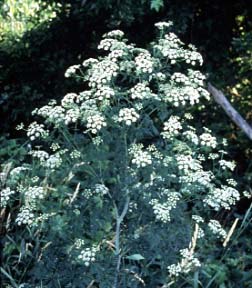 Poison Hemlock
Poison Hemlock
Family: Parsley, Apiaceae.
Habitat: Wet sites, gardens, roadsides, wastelands, pastures, and meadows.
Life cycle: Biennial, forming a rosette the first year and producing flowers and seed in the second.
First Year Growth Habit: Basal rosette of finely divided leaves with a pungent odor.
Second-Year Growth Habit: 2-7 feet tall, branched plant with flowers.
Leaves: Alternate, pinnately compound, finely divided, toothed, and glossy green.
Stems: Branched, waxy with purple blotches; hollow between nodes and grooved.
Flower: June – August (second year). Clusters of small white flowers with 5 petals in a loose, umbrella-like cluster, 2-7” across.
Root: Fleshy taproot.
Similar plants: During the first year, poison hemlock resembles wild carrot, but has a strong, pungent odor. Further, young leaves of wild carrot are more finely divided and its stem is hairy. At maturity, poison hemlock can be difficult to distinguish from water parsnip and water hemlock. Look for purple blotches on the stem to identify poison hemlock. Water hemlock (Cicuta maculata), which is also highly poisonous, has a magenta-streaked stem and lanceolate leaflets with sharply-toothed edges. Water parsnip (Sium suave) is not poisonous and has toothed lanceolate leaflets.
The problem is….This plant is highly poisonous to both humans and animals. Poison hemlock is a large and impressive plant which has been planted as an ornamental in some areas. It grows quickly in fertile soils.
Currently there are 21 weeds on the Ohio Prohibited Noxious Weed List:
- Shattercane (Sorghum bicolor) – February 8
- Russian thistle (Salsola Kali var. tenuifolia) – February 22
- Johnsongrass (Sorghum halepense L. (Pers.)) May 24
- Wild parsnip (Pastinaca sativa) – May 21
- Wild carrot (Queen Anne’s lace) (Daucus carota L.)
- Oxeye daisy (Chrysanthermum leucanthemum var. pinnatifidum) – May 3
- Wild mustard (Brassica kaber var. pinnatifida)
- Grapevines: when growing in groups of one hundred or more and not pruned, sprayed,cultivated, or otherwise maintained for two consecutive years. – February 15
- Canada thistle (Cirsium arvense L. (Scop.)) – March 29
- Poison hemlock (Conium maculatum) – May 31
- Cressleaf groundsel (Senecio glabellus)
- Musk thistle (Carduus nutans) – March 26
- Purple loosestrife (Lythrum salicaria) – April 17
- Mile-A-Minute Weed (Polygonum perfoliatum) – March 7
- Giant Hogweed (Heracleum mantegazzianum) – March 14
- Apple of Peru (Nicandra physalodes) – February 28
- Marestail (Conyza canadensis)
- Kochia (Bassia scoparia) – May 1
- Palmer amaranth (Amaranthus palmeri)
- Kudzu (Pueraria montana var. lobata) – April 11
- Japanese Knotweed (Polygonum cuspidatum) – April 2
Each week, for the next 21 weeks, I will post information and pictures on how to identify these invasive and harmful plants.




